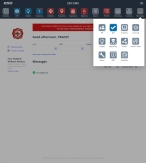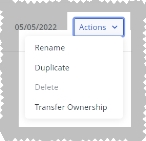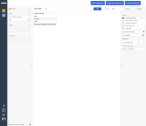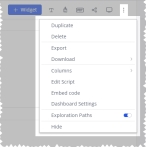Duplicate an existing dashboard
Instead of creating a new, blank dashboard, adding the widgets you need to it, then configuring all of those widgets, it may be much faster to find an existing dashboard that contains many of the widgets you want, duplicate it, and edit the copy to suit your needs. You can edit the filters on the dashboard itself and in the widgets in the dashboard, and you can add new widgets and remove unnecessary widgets as needed.
Note: You must have a designer role assigned to you in the ESO Insights module to duplicate an existing dashboard and modify the copy's content.
Information on role assignments is available in Assign user roles in the ESO Insights module.
-
 (If you have not done so already) Access the ESO Insights module in the ESO Suite.
(If you have not done so already) Access the ESO Insights module in the ESO Suite.
-
Do one of the following.
-
(If you are already working in the ESO Suite) Click the Home icon in the upper left corner of the screen.
-
 (If you have not yet logged in) Log in to the ESO Suite.
(If you have not yet logged in) Log in to the ESO Suite.
-
In a web browser, go to https://www.esosuite.net/EsoSuite.
The ESO Suite login screen appears.
-
Enter your user name, password, and agency name, then click Let's Go.
If MFA is enabled, the Multi-factor authentication dialog box appears, displaying one or more methods you can use to verify your login credentials. The number of methods that appear in the dialog box depends on what MFA methods your ESO Suite administrators enabled in the Admin module.
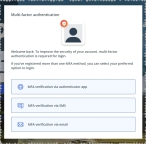
Click graphics
to open them.Information on enabling MFA and specific MFA methods is available in the Admin module online help, in Configure multiple-factor authentication.
Note: If your ESO Suite administrators have disabled MFA ("opted-out"), this dialog does not appear.
-
(If the Multi-factor authentication dialog box appears) Depending on which buttons appear in the dialog box, verify your login in one of the following ways.
 With an authenticator application.
With an authenticator application.
-
Click MFA verification via authenticator app.
The dialog box updates with boxes for entering the numbers of the authentication code, and the ESO Suite sends an authentication code to the authenticator application installed on your device.
-
Open your authenticator application and note the authentication code currently displayed.
-
Enter the authentication code displayed in the authenticator application.
-
Click Log In.
 With a text message (SMS).
With a text message (SMS).
-
Click MFA verification via SMS.
The dialog box updates with boxes for entering the numbers of the authentication code, and the ESO Suite sends an authentication code to the phone number recorded in your PM records and identified with MFA codes.
-
Enter the authentication code sent to your MFA-registered phone number.
-
Click Log In.
 With an email message.
With an email message.
-
Click MFA verification via email.
The dialog box updates with boxes for entering the numbers of the authentication code, and the ESO Suite sends an authentication code to your agency or department email address, recorded in your PM records.
-
Enter the authentication code sent to your agency or department email address.
-
Click Log In.
-
-
The ESO Suite landing screen appears.

Click graphics
to open them.Note: If MFA is enabled, you can access and manage your MFA options through the PM module, on the Settings > Account page, as described in Manage a user account. If your agency or department has enabled MFA but has not purchased the full-featured version of the PM module, you can access your own MFA settings by clicking Change my Multi-Factor Authentication settings on the landing screen, then using the Settings > Account page that appears. If your agency has not enabled MFA, the Change my Multi-Factor Authentication settings link does not appear on the landing screen.
-
-
On the top side of the home screen, click Insights.
Tip: If your screen or browser window is too narrow to display all your agency's ESO Suite module icons, an options icon appears on the right side of the icon bar. If you click the options icon, a menu appears containing additional module icons.
-
A list of all the dashboards in the ESO Insights module appears.
The capabilities you have in the ESO Insights module depends on what roles and permissions your ESO Suite administrator assigned to your user account. It also depends on what roles your ESO Insights manager assigned to your user account within the ESO Insights module.
Information on user accounts, roles, and permissions is available in Manage a user account. Information on roles assigned with the ESO Insights module is available in Assign user roles in the ESO Insights module.
-
-
Duplicate a dashboard in one of these ways.
 Inside an opened dashboard.
Inside an opened dashboard.
-
Click the name of the dashboard you want to work with.
Tip: If the list of dashboards is long, you locate the dashboard you want more easily, as described in Find and open an existing dashboard or report.
The dashboard opens and displays any widgets it contains, and the data those widgets link to.
-
Start the duplication process in one of these ways
-
In the upper right corner of the screen, click Duplicate Dashboard.
The Duplicate Dashboard box appears.
-
From the dashboard's menu, choose Duplicate.
The ESO Insights module duplicates the dashboard and automatically places you in the new dashboard. In the upper left corner of the screen, a
(1)appears at the end of the dashboard's name to indicate that you are in the copy of the original dashboard.
-
-
-
Depending on what appeared, do one of the following.
 The Duplicate Dashboard dialog box appeared.
The Duplicate Dashboard dialog box appeared.
-
For Datasource, click the field or the list icon to the right of the field, then select the appropriate single option from the menu that appears.
Note: If only one data source is available, that data source is chosen by default and a menu of data sources does not appear.
-
In New Dashboard Name, type the name of the dashboard as you want it to appear to differentiate the duplicated dashboard from the original dashboard.
-
Click Accept.
The ESO Insights module duplicates the dashboard and automatically places you in the new dashboard.
 The duplicated dashboard appeared, with a
The duplicated dashboard appeared, with a (1)at the end of the dashboard's name.-
In the upper left corner of the open dashboard, click at the end of the dashboard title, and change the name of the dashboard as needed.
The updated name appears in the dashboard list when you return to that page.
- (If necessary) Change the data source the dashboard draws information from, as described in Change a dashboard's data source.
-
-
Add, modify, and delete widgets on the new dashboard, as described in Manage widgets on a dashboard.





